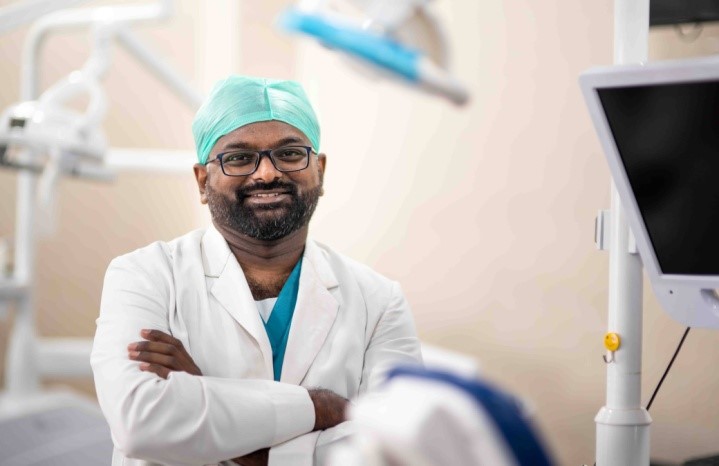- DEPARTMENT
- MEDICAL ONCOLOGY
- SURGICAL ONCOLOGY
- NEPHROLOGY
- UROLOGY
- MEDICAL GASTROENTEROLOGY
- SURGICAL GASTROENTEROLOGY
- NEUROLOGY
- NEURO SURGERY
- PEDIATRIC SURGERY
- PLASTIC SURGERY
- CARDIOLOGY
- GENERAL SURGERY
- ORTHOPEDICS
- OBSTETRICS & GYNECOLOGY
- GENERAL MEDICINE
- PEDIATRICS
- PULMONOLOGY
- DERMATOLOGY
- ENT
- MAXILLOFACIAL SURGEON
- DENTAL SCIENCES
- ANAESTHESIA & CRITICAL CARE
- EMERGENCY MEDICINE & TRAUMA
- PAIN MANAGEMENT
- PATHOLOGY
- PHYSIOTHERAPY
MAXILLOFACIAL SURGEON

DR. BUSA VAMSHIDHAR
BDS, MDS MAXILLOFACIAL SURGERY
Maxillofacial surgery, also known as oral and maxillofacial surgery (OMFS), is a specialized branch of surgery that deals with the diagnosis, treatment, and management of conditions affecting the face, jaws, mouth, and associated structures. Maxillofacial surgeons are highly trained professionals who possess expertise in both dentistry and medicine, allowing them to address a wide range of complex surgical problems involving the craniofacial region. In this comprehensive overview, we will delve into the intricacies of maxillofacial surgery, exploring its scope, significance, and advancements.
The Scope of Maxillofacial Surgery
Maxillofacial surgery encompasses a diverse array of surgical procedures and interventions aimed at addressing congenital anomalies, traumatic injuries, functional impairments, and aesthetic concerns affecting the craniofacial region. The scope of maxillofacial surgery includes:
Orthognathic Surgery
Orthognathic surgery involves the surgical correction of congenital or acquired skeletal discrepancies of the jaws (maxilla and mandible) to improve facial aesthetics, occlusal function, and airway patency. Common orthognathic procedures include:
Orthognathic Jaw Repositioning: Corrective osteotomies of the maxilla and mandible to reposition the jaws in cases of skeletal malocclusions, such as class II (overbite) or class III (underbite) malocclusions.
Genioplasty (Chin Surgery): Augmentation or reduction of the chin to enhance facial harmony and balance in conjunction with orthognathic surgery.
Bimaxillary Osteotomy: Simultaneous osteotomies of both the maxilla and mandible to address complex skeletal discrepancies and achieve optimal facial aesthetics and occlusal function.
Facial Trauma Surgery
Facial trauma surgery involves the management of injuries to the facial skeleton, soft tissues, and dentition resulting from accidents, assaults, falls, or sports-related injuries. Maxillofacial surgeons play a critical role in:
Fracture Reduction and Fixation: Open reduction and internal fixation (ORIF) of facial fractures, including fractures of the mandible, maxilla, zygoma, orbit, nasal bones, and frontal bone, using plates, screws, wires, or bone grafts.
Soft Tissue Reconstruction: Repair of lacerations, avulsions, and soft tissue injuries to the face, lips, tongue, and oral mucosa using techniques such as primary closure, local flaps, regional flaps, or microvascular free tissue transfer.
Dental Trauma Management: Evaluation and treatment of dental injuries, including tooth avulsions, fractures, luxations, and alveolar bone fractures, through splinting, reimplantation, endodontic therapy, or dental implant placement.
Temporomandibular Joint (TMJ) Surgery
Temporomandibular joint (TMJ) surgery involves the management of disorders affecting the TMJ complex, including internal derangements, osteoarthritis, ankylosis, and condylar fractures. Maxillofacial surgeons perform:
Arthroscopy: Minimally invasive arthroscopic procedures to visualize and treat intra-articular pathologies of the TMJ, such as disc displacement, synovitis, adhesions, and osteochondral defects.
Joint Reconstruction: Open joint procedures, including disc repositioning, eminectomy, meniscectomy, or total joint replacement, to restore normal TMJ anatomy and function in cases of severe degenerative disease or ankylosis.
Cleft Lip and Palate Surgery
Cleft lip and palate surgery involves the comprehensive management of orofacial clefts, including cleft lip, cleft palate, and associated craniofacial anomalies. Maxillofacial surgeons collaborate with multidisciplinary teams to:
Primary Repair: Surgical correction of cleft lip and palate defects during infancy to restore facial aesthetics, speech function, feeding ability, and dental arch alignment.
Secondary Revision: Secondary surgical procedures, including lip revision, alveolar bone grafting, pharyngeal flap surgery, and orthognathic surgery, to address residual deformities, velopharyngeal insufficiency, and maxillary hypoplasia in growing children and adolescents.
Head and Neck Oncologic Surgery
Head and neck oncologic surgery involves the diagnosis, staging, and treatment of benign and malignant tumors affecting the oral cavity, jaws, maxillofacial skeleton, salivary glands, thyroid gland, and cervical lymph nodes. Maxillofacial surgeons perform:
Tumor Resection: Surgical excision of oral, maxillofacial, and neck tumors with adequate margins to achieve complete tumor removal while preserving vital structures and maximizing functional and aesthetic outcomes.
Reconstructive Surgery: Microvascular reconstruction of complex defects following tumor resection using free tissue transfer (e.g., fibula flap, radial forearm flap, anterolateral thigh flap) to restore form and function and optimize quality of life for patients undergoing ablative surgery.
Aesthetic Facial Surgery
Aesthetic facial surgery involves elective procedures aimed at enhancing facial aesthetics, symmetry, and proportion to achieve desired cosmetic outcomes. Maxillofacial surgeons perform:
Rhinoplasty: Surgical reshaping of the nose to improve nasal aesthetics, function, and harmony with the facial profile, addressing dorsal hump reduction, nasal tip refinement, nasal deviation correction, and septoplasty for nasal airway obstruction.
Facial Skeletal Augmentation: Facial contouring procedures, such as cheek augmentation, chin augmentation, and mandibular angle augmentation, using autologous bone grafts, alloplastic implants, or injectable fillers to enhance facial harmony and balance.
Dental Implant Surgery
Dental implant surgery involves the placement of dental implants within the jawbone to support dental prostheses, such as crowns, bridges, or dentures, for the restoration of missing teeth and oral function. Maxillofacial surgeons perform:
Implant Placement: Surgical insertion of dental implants into edentulous or partially edentulous sites within the alveolar bone, ensuring proper implant position, angulation, and stability for osseointegration.
Bone Augmentation: Preprosthetic procedures, such as bone grafting, sinus lift, ridge augmentation, and guided bone regeneration, to enhance bone volume and density in deficient or atrophic alveolar ridges and facilitate implant placement and stability.
Sleep Apnea Surgery
Sleep apnea surgery involves the management of obstructive sleep apnea (OSA) and other sleep-disordered breathing conditions affecting the upper airway and respiratory function during sleep. Maxillofacial surgeons perform:
Upper Airway Surgery: Soft tissue procedures, including uvulopalatopharyngoplasty (UPPP), tonsillectomy, adenoidectomy, and tongue base reduction, to address anatomic obstructions and improve airway patency in patients with OSA or snoring.
Mandibular Advancement Surgery: Maxillomandibular advancement (MMA) or distraction osteogenesis procedures to reposition the maxilla and mandible anteriorly
